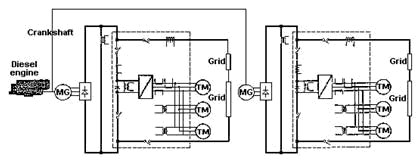Main
Generator
The source of power for
the high voltage circuits on SD90MAC locomotives is the Main Generator. This device
is actually misnamed on late model units, and the SD90MAC is no exception. In reality,
the machine produces 3 phase AC output rectified to DC by internal rectifier
assemblies. This operation qualifies the machine as an alternator, however early
model units used a bona-fide generator and when product evolution changed
the nature of the machine the past name stuck. Furthermore, as with past application,
the machine is actually wound as two separate machines producing two separate outputs.
In the past, these halves were connected in permanent series, or parallel for low
speeds and series for high speeds depending on locomotive model. One note of interest
concerning the Main Generator on SD90MAC locomotives is that the two generator halves
are now entirely independent.

The Main Generator or Traction Alternator, designated as TA-22, has
two electrically separate sets of output windings in its stator. SCR regulated CA8
(Companion Alternator) current flow for Main Generator excitation comes into
TA-22 on a field winding (rotor) shared by both halves. One set of stator
windings supplies power to truck #1 through the Traction Control Cabinet (TCC), the
other set to truck #2 through the TCC.
Traction Control Cabinet
The previous text mentioned a TCC or Traction Control Cabinet. The TCC houses the
components required for regulating the amount of power being passed to the traction
motors within a truck. This is commonly referred to as the inverter, but make no
mistake that the TCC is actually a home for two inverters, one per truck. Each
inverter receives DC input from its respective Main Generator half. Each inverter can
now regulate the voltage and frequency of AC power sent to the motors of the truck
which it supplies.
Each inverter contains three phase modules which use Gate Turn-Off
thyristors (GTOs) to switch the DC input power at rapid rates to create some
resemblance of AC output to the traction motors. This pulsing of GTOs results in
voltage spikes on the input voltage. To dampen the spikes on DC Link, large
capacitors connect in parallel with the input. Output spikes are dampened by
"snubber" circuitry, much of which is internal to each phase module.
Ground Relay
The presence of AC traction systems as well as the independence of the
TA-22 halves creates a few complications in the ground fault detection
circuitry. Of course, the circuitry detects the presence of grounds in the high
tension circuits. And as before, Ground Relay does detect open Traction Alternator
rectifiers (single phasing of generator) by use of transducers and resistors applied
in parallel with the generator's normal output path. Some components and wiring not
present on DC traction units now appear in the circuit by necessity.
©
2005 William C. Slim
http://www.okthepk.ca
|

